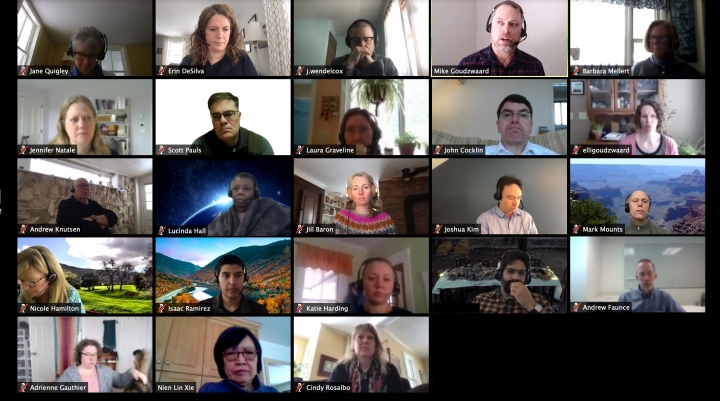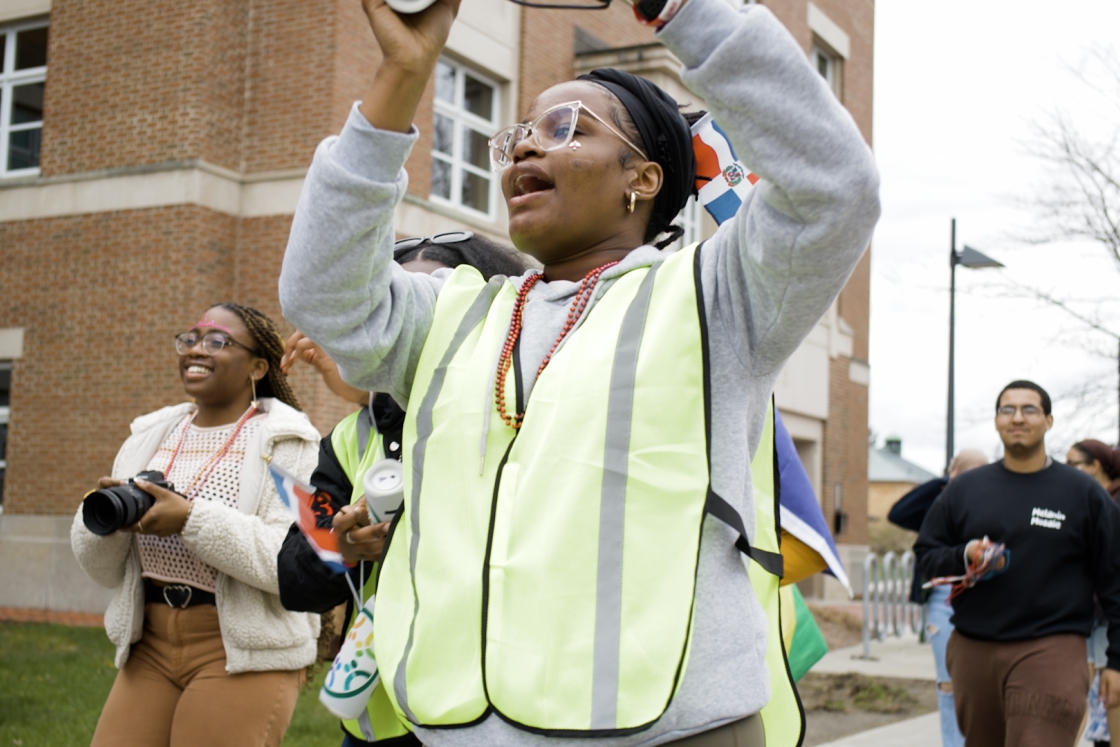As faculty race to prepare to teach their spring term courses remotely, they are not working alone.
As of this week, 50 departmental teams consisting of learning designers, instructional technology experts, librarians, accessibility specialists, and others are collaborating around the clock with every academic department and program to make sure that faculty and students will have what they need to maintain as much academic continuity as possible during the COVID-19 pandemic.
The primary goal of remote learning is academic continuity--not to build a full-blown online program designed from scratch for distance learners, says Erin DeSilva, assistant director of Learning Design and Technology.
“Nobody signed up for this,” DeSilva says. “What we’re doing is putting together a patch. We’re doing it creatively and thoughtfully and with all of the resources and brainpower that is at Dartmouth, but it’s a patch. Sometimes that’s what the world needs to get from one place to another.”
A ‘Small, Tight-Knit Community’
“We’re in new territory--no one knows what’s going to work well and what’s not,” says Joshua Kim, director of online programs and strategy at the Dartmouth Center for the Advancement of Learning (DCAL) and a member of Dartmouth’s COVID-19 task force.
“What’s working in our favor is that there are strong relationships on this campus between faculty and non-faculty educators. There’s trust,” Kim says. “We’re dependent on each other now to serve these remote students, and we’re at a good place because of our small, tight-knit community.”
DCAL and Learning Design and Technology have created a Teach Remotely website to compile and share resources for faculty to make the transition to teaching in a virtual classroom.
Among the tools posted on that site is a student survey that Assistant Professor of Sociology Kimberly Rogers adapted from one shared by the academic Twitter community (#AcademicTwitter). The survey asks students everything from their anticipated access to technology and internet to more personal concerns about the coming term, such as housing, food security, and health care.
“As concerned as we are about our own families and communities and the College, the students are stressed out, too,” says Rogers, who will be teaching “Introduction to Sociology” and “Status and Power in Social Interaction” in the spring. “I think it’s integral that we reach out to them sooner rather than later, even if we don’t have all the answers. It doesn’t need to be perfect, it just needs to happen.”
Challenges and Opportunities
Among the challenges: figuring out the right blend of synchronous face-to-face instruction and independent work for classes whose students may be dispersed across multiple time zones with differing access to the internet and other tools.
The solutions for each discipline may be different. In many math and science courses, for instance, faculty will be using dynamic whiteboards that allow them to annotate slides in real time.
“The biggest challenge for me is that I do extensive board work in ‘EARS 70,’” says Robert Hawley, associate professor of earth sciences, of his advanced glaciology seminar. “We do a lot of equation derivations and things like that. With software such as TechSmith Relay, I can annotate my slides using a pencil on the iPad.”
Hawley has experience with this technology because he recently helped redesign one the earth sciences department’s introductory courses (“EARS 6”) through DCAL’s Gateway Initiative, which builds active learning into larger introductory courses. Now he is helping his colleagues adapt.
“We’re all having to solve the same problem to make these online lectures, and as with any technology problem there are a million ways to solve it,” Hawley says. “If a faculty member has never done it before, there are a lot of hurdles. So I made a little video of how I switch between my lecture slides and my webcam and how I annotate slides. It may not be the right way for everyone to solve this problem, but if it’s the right way for somebody, then it will be helpful.”
Meanwhile, many humanities classes that are organized around the give and take of in-person discussion are exploring ways to approximate that experience on Zoom or other media.
Roberto Rey-Agudo, language program director for the Department of Spanish and Portuguese, is teaching “Spanish 3” in the spring and has been working with language faculty in his department and across campus to adapt their curriculum to the circumstances.
“A unique thing about language classes is the interaction in class between students and between teacher and students,” Rey-Agudo says. “In transitioning to teaching remotely, we are actively trying to maintain that sense of cohort and community with our students. We can’t reproduce that exactly, but we’ve been thinking about how we can offer interaction for students. We’re trying to switch our focus from synchronous to asynchronous interactions, and trying to keep as many daily Zoom meetings as we would normally have, but to use those meetings for things you really cannot do outside of class time--to check in on how we’re doing and answer questions.”
And students will still participate in language drills, he says. “We’re working with the Rassias Center so that we can have even 15 to 20 minutes a day for students to get that extra practice, and for our students who are teaching assistants to not lose work study income.”
Creativity and Empathy
Last week, Rey-Agudo helped organize a webinar for language faculty with George Mason University’s Esperanza Román Mendoza, an expert on remote language learning.
“The general principles that she gave us were really useful,” Rey-Agudo says. Among them: focusing on delivering the essentials, encouraging self-care, and limiting the number of new technologies adopted in any given class.
“If I try to introduce something, but an econ professor uses Zoom, and the professor of writing is using something else, that creates extra challenges for the students,” he says.
These may be uncharted waters, but “the general principles are prioritizing care, compassion, and kindness; stay calm; keep it simple; practice flexibility,” says Kim. “There’s an emphasis on professors having a connection with students. That’s what sets Dartmouth apart.”
“I am most encouraged by the thoughtful approach that every single faculty member I’m talking to is taking,” says DeSilva, speaking via Zoom from her home, where her husband, Associate Professor of Anthropology Jeremy DeSilva, has been recording videos on fossils for his spring classes, wearing “a different nerdy science T-shirt for each one.”
“These faculty are so on it. They’re thinking creatively, they’re maintaining learning objectives and high levels of student empathy, and thinking about the experience that students are going to have and how they’re going to learn in this new way,” she says. “They’re inserting themselves and their passion into this content.”
Hawley agrees. “As many challenges and hardships that we on the faculty are going through trying to change our courses, I continue to be incredibly grateful that I work in an industry where what we do can be converted into something that can be done remotely,” he says.
“We’re still open for business. We’re still exchanging information and distributing knowledge and creating knowledge, and it’s a privilege to be able to do that.”
For the latest information on Dartmouth’s response to the pandemic, visit the COVID-19 website.
Hannah Silverstein can be reached at hannah.silverstein@dartmouth.edu.

